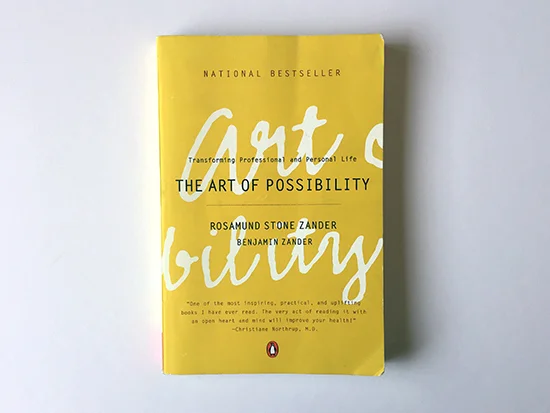I love this book. It is one of the few books I know I would be very upset if I lost. It regularly makes the journey down from my bookshelf onto my desk or bedside table and I never tire of rereading passages. In some ways I feel the book houses the kind of optimism that I wish I had in greater measure. Not a Pollyanna, life is great (even when it’s not) kind of outlook, but a sense that we can affect so much in our lives if we just realised it. That the world is a place full of opportunity and possibility and we are active participants within that. It’s something I know to be true, but sometimes find hard to remember.
The authors of this book – Rosamund and Benjamin Zander – are a couple who work in very different fields. She is a family therapist and a painter, he is the conductor of the Boston Philharmonic Orchestra and a teacher of music students. Together they bring insights from their spheres of activity; their stories and examples are inspiring and motivating. But the book is more than just a series of case studies and examples. It has a practical element, giving the reader the tools, or practices, to work on their own personal development in the art of possibility. The premise of the book is that many of the things we encounter in our lives, that seem to block us, appear that way because of assumptions that we all carry around with us. If we can learn to reframe how we perceive things, we can challenge these assumptions and “lift off from that world of struggle and sail into a vast universe of possibility.”
The method they use throughout the book is to see these small acts of reframing as games that we can play. (In this context a game is an ‘alternative framework for engagement, exploration and growth.’) One example I particularly like is the game ‘being a contribution’. So often we are bound up in the ‘success’ game where we judge ourselves by other people’s standards, are highly critical of our failures, and feel that nothing is ever quite good enough. In the book Ben describes how he began to play a game called ‘I am a contribution’. The game is simple – first you declare yourself a contribution. Then you ‘throw yourself into life as someone who makes a difference, accepting that you may not understand how or why.’ The emphasis shifts from the competitive, self-focused, accumulation of wealth and status that people often use to define success, to a more outward-looking place of engagement with the world. The question becomes less ‘have I done enough, what have I accomplished?’ and more ‘how have I added to other people’s experiences, how have I made a difference?’. And, let’s be clear here, the authors pass no judgement on what you define as a contribution – it’s not meant to make you feel bad that you’re not devoting your life to charity work. In terms of the things I talk about here, artistic endeavour is definitely a contribution; it adds to the lives of the person who creates it and to those who experience it.
The strength of the book is that each practice provides ‘an opportunity for personal evolution that promises to enhance not only the reader’s life but the organisations and relationships in which he or she participates.’ Unlike a lot of self-help books, which are very self-focused, it sets out ways to promote possibility for, and in, others. For me, any approach, which asks us to remember how we are connected with others, and the positive role we can play in other people’s lives, is really important. It can be so easy to get sucked into worrying about ourselves, how things are going for us, what’s not working, what needs improving, that we forget just how much we can give and do for the world around us, in small, unique and valuable ways. And shouldn’t that be the point? That we enhance and benefit those around us? That we create a world of possibility for everyone, not just ourselves?
“If I were to wish for anything I should not wish for wealth and power, but for the passionate sense of what can be, for the eye, which, ever young and ardent, sees the possibility. Pleasure disappoints, possibility never. And what wine is so sparkling, what so fragrant, what so intoxicating as possibility?”
– Soren Kierkegaard
The Art of Possibility by Rosamund Stone Zander & Benjamin Zander. Published by Penguin
